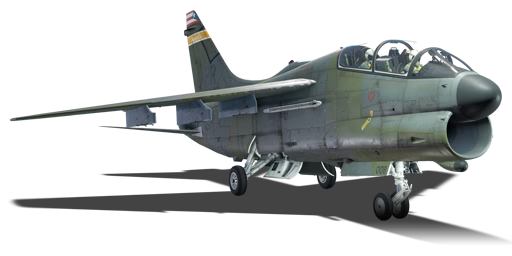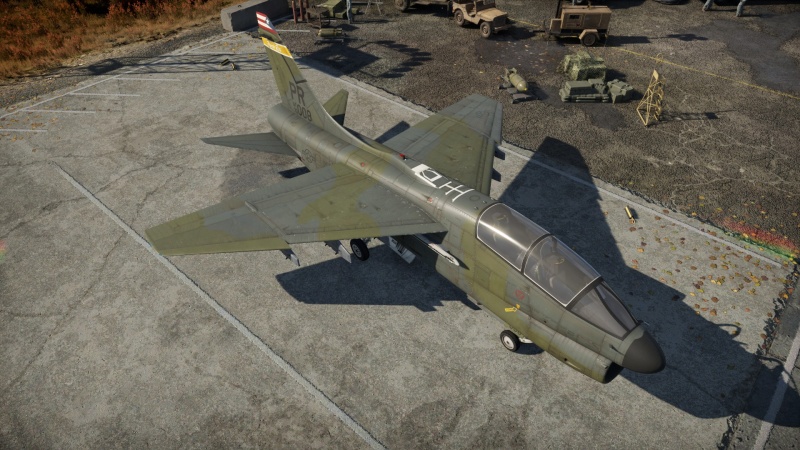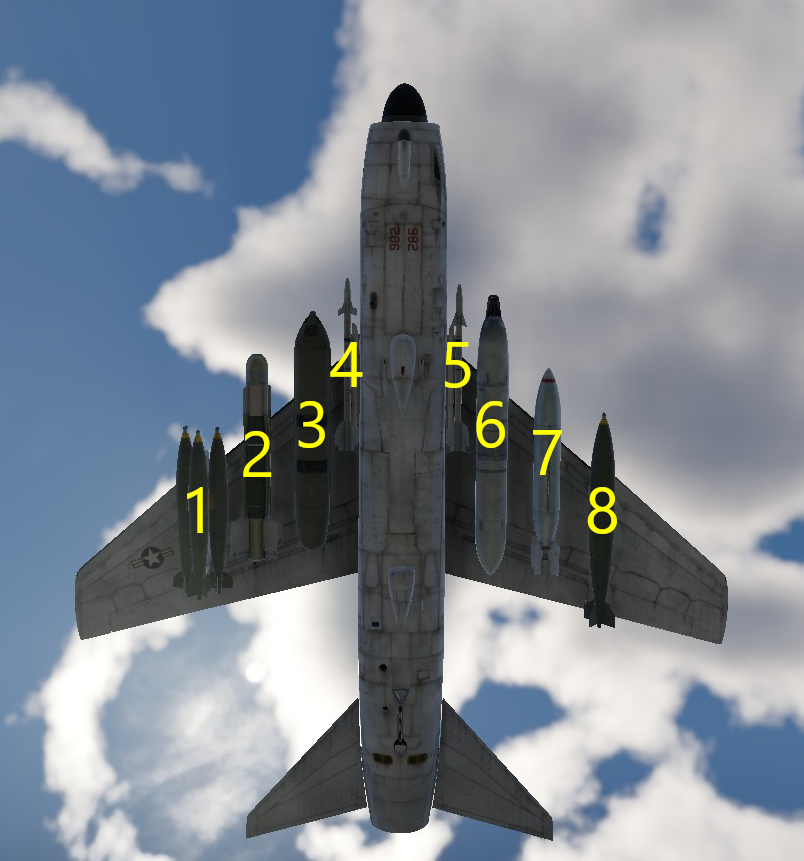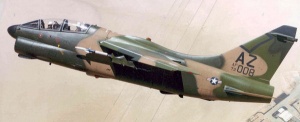A-7K
| This page is about the gift American strike aircraft A-7K. For other versions, see A-7 Corsair II (Family). |
Contents
Description
The A-7K Corsair II is a subsonic (originally naval) strike aircraft, produced by Vought Aeronautics Division of LTV Aerospace Corporation. The A-7K was a dual seat variant of the A-7D built for the USAF; the A-7K specifically for the Air National Guard by lengthening the nose of the aircraft. The A-7K was mostly used for training, with 30 built to supplement the A-7Ds already in service. In the 1980s, several aircraft were equipped with a thermal sight, and this is the variant represented in-game.
The A-7K was introduced during Update "Sky Guardians" as a reward for the "Repair Factory" event, and has a large advantage over the tech tree A-7D, as like the A-7E it gains access to a thermal sight, which makes spotting targets from a distance much more manageable. It has the same anti-tank armament as the A-7D, with access to the Maverick B and the GBU-8 "Hobo"; this means the aircraft is still incapable of using guided munitions at night despite having access to a thermal sight. The anti-air capability is much improved compared to both the D and E variants of the airframe, with the AIM-9L serving as the top air-to-air missile, although at the battle rating the A-7 is placed at these serve purely for self defense.
General info
Flight performance
Describe how the aircraft behaves in the air. Speed, manoeuvrability, acceleration and allowable loads - these are the most important characteristics of the vehicle.
| Characteristics | Max speed (km/h at 0 m - sea level) |
Max altitude (metres) |
Turn time (seconds) |
Rate of climb (metres/second) |
Take-off run (metres) | |||
|---|---|---|---|---|---|---|---|---|
| AB | RB | AB | RB | AB | RB | |||
| Stock | 1,114 | 1,108 | 12497 | 35.4 | 37.0 | 42.2 | 41.9 | 1,000 |
| Upgraded | ___ | 1,123 | __._ | 35 | __._ | 55.0 | ||
Details
| Features | |||||
|---|---|---|---|---|---|
| Combat flaps | Take-off flaps | Landing flaps | Air brakes | Arrestor gear | Drogue chute |
| ✓ | ✓ | ✓ | ✓ | ✓ | X |
| Limits | ||||||
|---|---|---|---|---|---|---|
| Wings (km/h) | Gear (km/h) | Flaps (km/h) | Max Static G | |||
| Combat | Take-off | Landing | + | - | ||
| 1,254 | 407 | 484 | 457 | 406 | ~10 | ~4 |
| Optimal velocities (km/h) | |||
|---|---|---|---|
| Ailerons | Rudder | Elevators | Radiator |
| < 700 | < 690 | < 500 | - |
Engine performance
| Engine | Aircraft mass | |||||||
|---|---|---|---|---|---|---|---|---|
| Engine name | Number | Basic mass | Wing loading (full fuel) | |||||
| Allison TF-41-A-2 | 1 | 9,196 kg | 395 kg/m2 | |||||
| Engine characteristics | Mass with fuel (no weapons load) | Max Gross Weight | ||||||
| Weight (each) | Type | 15m fuel | 20m fuel | 30m fuel | 45m fuel | 53m fuel | ||
| 1,592 kg | Low-bypass turbofan | 10,562 kg | 10,910 kg | 11,768 kg | 13,053 kg | 13,748 kg | _,___ kg | |
| Maximum engine thrust @ 0 m (RB/SB) | Thrust to weight ratio @ 0 m (100%) | |||||||
| Condition | 100% | WEP | 15m fuel | 20m fuel | 30m fuel | 45m fuel | 53m fuel | MGW |
| Stationary | 4,741 kgf | - | 0.45 | 0.43 | 0.40 | 0.36 | 0.34 | _.__ |
| Optimal | 6,378 kgf (200 km/h) |
- | 0.60 | 0.58 | 0.54 | 0.49 | 0.46 | _.__ |
Survivability and armour
Examine the survivability of the aircraft. Note how vulnerable the structure is and how secure the pilot is, whether the fuel tanks are armoured, etc. Describe the armour, if there is any, and also mention the vulnerability of other critical aircraft systems.
Modifications and economy
Armaments
| Ballistic Computer | |||
|---|---|---|---|
| CCIP (Guns) | CCIP (Rockets) | CCIP (Bombs) | CCRP (Bombs) |
| |
|
|
|
Offensive armament
The A-7K is armed with:
- A choice between two presets:
- 1 x 20 mm M61A1 cannon, chin-mounted (500 rpg)
- 1 x 20 mm M61A1 cannon + 120 x countermeasures
Suspended armament
The A-7K can be outfitted with the following ordnance:
| 1 | 2 | 3 | 4 | 5 | 6 | 7 | 8 | ||
|---|---|---|---|---|---|---|---|---|---|
| 20 mm GAU-4 cannons (1,200 rpg) | 1 | 1 | |||||||
| 30 mm GAU-13/A cannons (353 rpg) | 1 | 1 | |||||||
| 250 lb LDGP Mk 81 bombs | 4, 6 | 6 | 6 | 4, 6 | |||||
| 250 lb Mk 81 Snakeye bombs | 4, 6 | 6 | 6 | 4, 6 | |||||
| 500 lb LDGP Mk 82 bombs | 4, 6 | 6 | 6 | 4, 6 | |||||
| 500 lb Mk 82 Snakeye bombs | 4, 6 | 6 | 6 | 4, 6 | |||||
| 750 lb M117 cone 45 bombs | 1 | 4 | 2 | 2 | 4 | 1 | |||
| 1,000 lb LDGP Mk 83 bombs | 2, 3 | 3 | 3 | 2, 3 | |||||
| 2,000 lb LDGP Mk 84 bombs | 1 | 1 | 1 | 1 | 1 | 1 | |||
| 2,000 lb LDGP Mk 84 Air bombs | 1 | 1 | 1 | 1 | 1 | 1 | |||
| 2,000 lb GBU-8 bombs | 1 | 1 | 1 | 1 | |||||
| BLU-27/B incendiary bombs | 1 | 1 | 1 | 1 | 1 | 1 | |||
| FFAR Mighty Mouse rockets | 19 | 19 | 19 | 19 | 19 | 19 | |||
| AGM-65B missiles | 3 | 3 | |||||||
| AIM-9J Sidewinder missiles | 1 | 1 | |||||||
| AIM-9L Sidewinder missiles | 1 | 1 | |||||||
| LANA Flir Navigation Pod | 1 | ||||||||
| Maximum permissible loadout weight: 7,260 kg Maximum permissible wing load: 3,630 kg Maximum permissible weight imbalance: 2,900 kg | |||||||||
| Default weapon presets | |
|---|---|
| |
The A-7K can carry huge amount of suspended armament for ground attack use. Aircraft starts of with up to 24 x 250 lb LDGP Mk 81 bombs, which are enough to dispose of a base in Air RB. After researching 24 x 500 lb Mk 82 bombs the plane is capable of destroying 2 bases in one run. It can also take 14 x 750 lb M117, 12 x 1,000 lb LDGP Mk 83 and 6 x 2,000 lb LDGP Mk 84 bombs, which are more useful in Ground RB since they offer larger blast radii. For use against ground vehicles the plane can carry 114 x FFAR Mighty Mouse rockets, 4 x 2,000 lb GBU-8 TV-guided bombs and 6 x AGM-65B TV-guided air-to-ground missiles. Guided munitions are used with the LANA Flir Navigation Pod, which provides thermal vision over the battlefield, making spotting targets easier. That makes the A-7K a very potent CAS option that can bring havoc upon the enemy team. The aircraft can also carry 6 x BLU-27/B incendiary bombs, and for self-defense against enemy planes it starts with 2 x AIM-9J air-to-air missiles, which can be upgraded to AIM-9Ls. For increased firepower, the plane can take 2 x 20 mm GAU-4 gunpods (with 1,200 rounds each) or 2 x 30 mm GAU-13/A gunpods (with 353 rounds each).
Usage in battles
- Air Realistic Battles
In Air RB, the A-7K presents a very limited utility, mainly attacking ground targets. Bases are an option, but its low top speed combined with the limited manoeuvrability while carrying ordnance make it a perilous mission, as you are an easy target for any fighter that can show up, and friendly planes will almost always get there before you do. Flying to the side low to the ground is recommended, until enemy aircraft will back out or start fighting with your team. Then you can target respawning bases behind the frontline, and once you are done, if you didn't get a chance to do so, you can try to use your missiles to take down enemies, but keep in mind you don't want to start actively fighting. If a fighter decides to target you, strongly consider dropping your ordnance and abandoning any bombing run to increase your chances of survival. The strongest enemies you can encounter are the MiG-29, F-16 and F-14. There is nothing the A-7K can realistically do to counter those aircraft, so you want to stay unseen as long as it is possible, though the AIM-9L can occasionally get rid of an unsuspecting target.
- Ground Realistic Battles
As a strike aircraft, the A-7K is exceptionally well equipped for CAS missions. Guided ordnance with LANA Flir navigation pod make a very potent combo, allowing you to keep distance from SPAAGs, though SAM SPAAs are still a huge threat, especially the Pantsir-S1, as you spawn within its range. The best thing you can do is fly close to the ground, go to the side of the map and only reveal yourself when you are close to the battlefield. Then, you want to quickly spot SPAAs and target them with your AGMs or guided bombs using the navigation pod. You can also go and check if there are any helicopters up and destroy them so your team can focus more on objectives.
Pros and cons
Pros:
- Airframe is relatively sturdy
- Carries enough ordnance to destroy 2 bases
- Guided munitions make it very effective for CAS
- Gets LANA Flir navigation pod for spotting ground targets
- The internal 20 mm M61A1 rotary cannon can shred enemy aircraft
- AIM-9Ls can be pretty effective for air-to-air combat
Cons:
- Poor flight performance
- Easy target for enemy aircraft
- Lacks a functional radar
- Prone to catch fire when hit
History
As the United States Air Force was pulling out of South Asia in 1975 at the end of the Vietnam War, the A-7Ds operating there were returned to the United States. The U.S Department of Defence pushed for these Corsair IIs to be transferred to the U.S Air National Guard, as these aircraft were starting to become obsolete in frontline service, and the LTF-program was almost finished, which would give the Air Force the General Dynamics F-16A Falcon to replace the A-7D in the frontline attack role. The U.S. Air National Guard, unlike the USAF, would ultimately decide that with the transfer of the A-7Ds, they would require a special two-seat training variant to ensure maximum combat training effectiveness on these "new" aircraft.
This special twin-seat training variant designated the A-7K, retained all the features of the base A-7D along with being fully combat capable. The A-7K, and the U.S ANG A-7Ds, would serve for many years more after their "retirement" from the USAF, undergoing a few mid-life upgrades, most famously the LANA-program, which provided the A-7K and A-7D with a new thermal targeting and navigation pod[1].
Media
- Skins
See also
- Related development
External links
References
| Chance Vought Aircraft | |
|---|---|
| Fighters | |
| Corsair | F4U-1A · F4U-1A (USMC) · F4U-1C · F4U-1D · F4U-4 · F4U-4B · F4U-4B VMF-214 |
| Float planes | O3U-1 · OS2U-1 · OS2U-3 |
| Attackers | AU-1 |
| Bombers | SB2U-2 · SB2U-3 |
| Jet aircraft | |
| Corsair II | A-7D · A-7E · A-7K |
| Crusader | F8U-2 · F-8E |
| Export | V-156-B1 · V-156-F · ▄Corsair F Mk II · F4U-7 · ▄F-8E(FN) |
| Captured | ▅F4U-1A |
| USA jet aircraft | |
|---|---|
| Fighters | |
| F9F | F9F-2 · F9F-5 · F9F-8 |
| F-80 | F-80A-5 · F-80C-10 |
| F-84 | F-84B-26 · F-84F · F-84G-21-RE |
| F-86 | F-86A-5 · F-86F-25 · F-86F-2 · F-86F-35 |
| F-89 | F-89B · F-89D |
| F-100 | F-100D |
| F-104 | F-104A · F-104C |
| F-4 | F-4C Phantom II · F-4E Phantom II · F-4J Phantom II · F-4S Phantom II |
| F-5 | F-5A · F-5C · F-5E · F-20A |
| F-8 | F8U-2 · F-8E |
| F-14 | F-14A Early · ▄F-14A IRIAF · F-14B |
| F-15 | F-15A · F-15C MSIP II · F-15E |
| F-16 | F-16A · F-16A ADF · F-16C |
| Other | P-59A · F2H-2 · F3D-1 · F3H-2 · F4D-1 · F11F-1 |
| Strike Aircraft | |
| FJ-4 | FJ-4B · FJ-4B VMF-232 |
| A-4 | A-4B · A-4E Early |
| A-7 | A-7D · A-7E · A-7K |
| AV-8 | AV-8A · AV-8C · AV-8B Plus · AV-8B (NA) |
| A-10 | A-10A · A-10A Late · A-10C |
| F-111 | F-111A · F-111F |
| Other | A-6E TRAM · F-105D · F-117 |
| Bombers | |
| B-57 | B-57A · B-57B |







